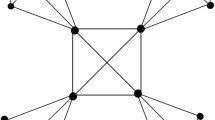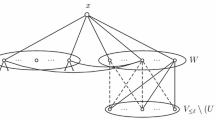Abstract
Let \(G=(V, E)\) be a simple graph and denote the set of edges incident to a vertex v by E(v). The neighbor sum distinguishing (NSD) total choice number of G, denoted by \(\mathrm{ch}_{\Sigma }^{t}(G)\), is the smallest integer k such that, after assigning each \(z\in V\cup E\) a set L(z) of k real numbers, G has a total coloring \(\phi \) satisfying \(\phi (z)\in L(z)\) for each \(z\in V\cup E\) and \(\sum _{z\in E(u)\cup \{u\}}\phi (z)\ne \sum _{z\in E(v)\cup \{v\}}\phi (z)\) for each \(uv\in E\). In this paper, we propose some reducible configurations of NSD list total coloring for general graphs by applying the Combinatorial Nullstellensatz. As an application, we present that \(\mathrm{ch}^{t}_{\Sigma }(G)\le \Delta (G)+3\) for every subcubic graph G.
Similar content being viewed by others
References
Alon N (1999) Combinatorial Nullstellensatz. Comb Probab Comput 8:7–29
Bartnicki T, Grytczuk J, Niwczyk S (2009) Weight choosability of graphs. J Graph Theory 60(3):242–256
Bondy JA, Murty USR (2008) Graph theory, GTM, vol 244. Springer, Berlin
Chang G, Narayanan N (2013) Strong chromatic index of 2-degenerate graphs. J Graph Theory 73(2):119–126
Ding L, Wang G, Yang G (2014) Neighbor sum distinguishing total coloring via the combinatorial Nullstellensatz. Sin China Ser Math 57(9):1875–1882
Dong A, Wang G (2014) Neighbor sum distinguishing total coloring of graphs with bounded maximum average degree. Acta Math Sin 30(4):703–709
Galvin F (1995) The list chromatic index of a bipartite multigraph. J Comb Theory Ser B 63:153–158
Han M, Lu Y, Luo R Neighbor sum distinguishing total coloring and list neighbor sum distinguishing total coloring, to appear in Discrete Appl. Math
Hu X, Chen Y, Luo R, Miao Z (2017) Neighbor sum distinguishing index of 2-degenerate graphs. J Comb Optim 34(3):798–809
Jin J, Wei Y (2017) A note on \(3\)-choosability of plane graphs under distance restrictions. Discrete Math Algorithm Appl 9(1):1750011
Karst N, Langowitz J, Oehrlein J, Troxell DS (2017) Rado \(k\)-chromatic number of cycles for large \(k\). Discrete Math Algorithm Appl 9(3):1750031
Li Y, Hu X (2017) The linear \(2\)-arboricity of sparse graphs. Discrete Math Algorithm Appl 9(4):1750047
Li H, Liu B, Wang G (2013) Neighbor sum distinguishing total coloring of \(K_4\)-minor-free graphs. Front Math China 8(6):1351–1366
Li H, Ding L, Liu B, Wang G (2015) Neighbor sum distinguishing total colorings of planar graphs. J Comb Optim 30(3):675–688
Pilśniak M, Woźniak M (2015) On the total-neighbor distinguishing index by sums. Graphs Comb 31:771–782
Seamone B (2012) The 1-2-3 Conjecture and related problems: a survey, arXiv:1211.5122v1
Wong T, Zhu X (2011) Total weight choosability. J Graph Theory 66:198–212
Wong T, Zhu X (2016) Every graph is \((2,3)\)-choosable. Combinatorica 36(1):121–127
Yao J, Yu X, Wang G, Xu CQ (2017) Neighbor sum distinguishing total coloring of \(2\)-degenerate graphs. J Comb Optim 34(1):64–70
Author information
Authors and Affiliations
Corresponding author
Additional information
Supported by NSFC (11571149 and 11571168).
Rights and permissions
About this article
Cite this article
Lu, Y., Xu, C. & Miao, Z. Neighbor sum distinguishing list total coloring of subcubic graphs. J Comb Optim 35, 778–793 (2018). https://doi.org/10.1007/s10878-017-0239-5
Published:
Issue Date:
DOI: https://doi.org/10.1007/s10878-017-0239-5




